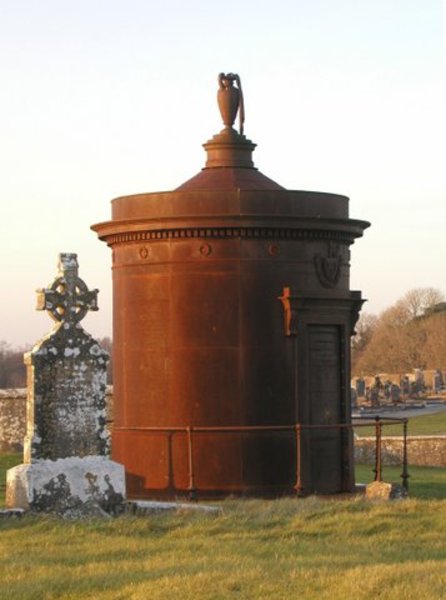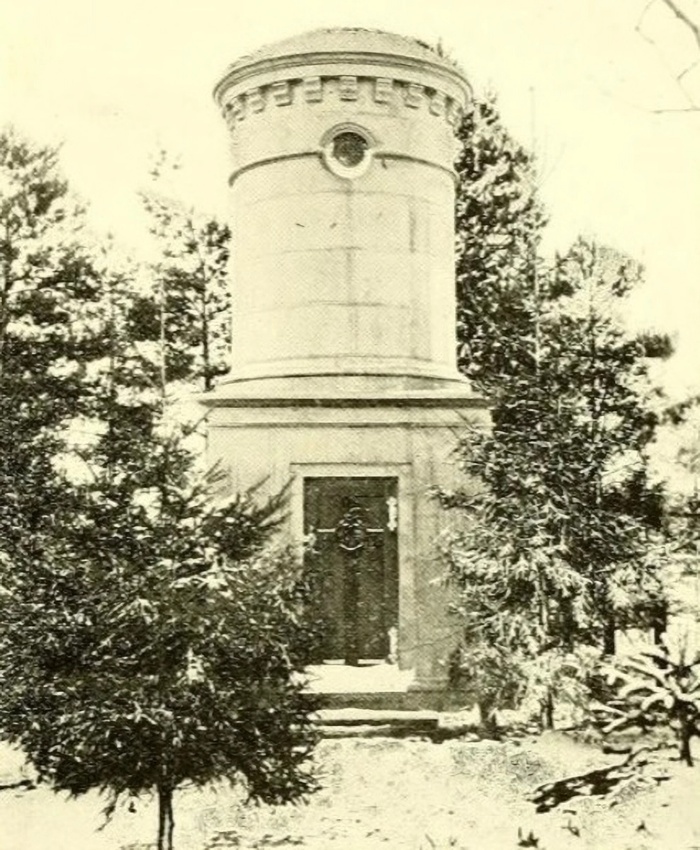Mausolea as low-tech gas harvesting and dispensing stations. Photographic evidence. Fri 03 December 2021

Ireland's unique Dennis Mausoleum. Source: The Mausolea & Monuments Trust
Built - or, actually, welded - in 1865, the Dennis Mausoleum is the only cast-iron 'mausoleum' in the Irish and British isles.
Does it remind you of anything?
Try this:

Bottled gas - a 20th century innovation. Source
On April 13, 1963, balloonist Ed Yost re-invented the hot air balloon.
Hot air balloons making high-risk, long-distance flights over the sea need the high density power of bottled inflammable gas. Propane had been discovered just 50 years earlier. And just a few years before the invention of the steel gas canister.
It's odd then that the first manned balloon crossing of the English Channel is credited to Colonel Burnaby - who took off from Dover's town gasworks on 23 March 1882.
Similarly, the first manned balloon flight over the North Sea is credited to Sir Claude Champion de Crespigny in 1883.
From The Mausolea & Monuments Trust:
The 4th Baronet served in both the navy and army and was a well known sportsman and athlete, (riding steeplechase, hunting big game, swimming, diving, sculling). Sir Claude was also the first to cross the North Sea in a balloon in 1883.
Crespigny also took off from a gasworks: Maldon gasworks in Essex.
Given it took modern fabrics, modern gas bottles and modern burner technology for Yost to balloon across the English Channel in 1963, it is unlikely that 81 years earlier, Burnaby crossed the Channel in a hot air balloon. It is also highly unlikely that de Crespigny crossed the North Sea in a hot air balloon.
They must have used another gas. Hydrogen, helium, perhaps methane. Or a blend of gasses.
There are many clues about where and how they were making lighter than air gas.
De Crespigny planned to take off for his North Sea flight from his home. He commissioned the Champion de Crespigny mausoleum in the grounds of his home - Champion Lodge near Maldon, Essex.
From The Mausolea & Monuments Trust:
Built in 1910 by Sir Claude Champion de Crespigny, 4th Baronet (b.1847-d.1935)
The Crespigney mausoleum was a tall story. Crespigney - The Mausolea & Monuments Trust
Apparently, the Crespigneys were laid to rest standing up. Perhaps Claude was having to pack them in. Because he also had an 'eccentric' interest in how the living were converted into the floating.
From Champion de Crespigny Baronets:
He was eccentric enough to bribe hangman James Berry into accepting him as assistant executioner on the occasion of a triple hanging in Carlisle on 8 February 1886.
And perhaps in collecting them. Another - unverified - account suggests de Crespigny shipped 17 corpses from Europe, including his son, to put in his Maldon mausoleum.
The story just doesn't smell right.
So take a sniff at this selection of home gas plants - each allegedly a mausoluem.
Starting with de Crespigny's now-demolished plant at Maldon, Essex:
| Mausoleum | Name | Roof Shape | Occulus 1 | Notes | Location |
|---|---|---|---|---|---|
 |
Champion de Crespigny | Dome on drum | High above door | 1910. Now destroyed. | CM9 8NU (Google Maps), (Google Streetview), (OpenStreetMap), (NLS), (Flickr images) |
 |
Constable | Dome on drum | Top | 1792 | Halsham, East Yorkshire (Google Maps), (Google Streetview), (OpenStreetMap), (NLS), (Flickr images) |
 |
Dennis | Cone on drum | Not visible | 1865 in cast iron | Old Clonberne Graveyard, Co Galway (Google Maps), (Google Streetview), (OpenStreetMap), (NLS), (Flickr images) |
 |
Fraser | Dome on drum | Not visible | 1808 | Cluny Old Kirkyard, AB51 7RS (Google Maps), (Google Streetview), (OpenStreetMap), (NLS), (Flickr images) |
 |
Freeman | Dome on drum | Not visible | 1750 | Fawley Green, Buckinghamshire, OX12 9YW (Google Maps), (Google Streetview), (OpenStreetMap), (NLS), (Flickr images) |
 |
Hamilton | Dome on drum | Not visible | 1842 | Hamilton, Scotland (Google Maps), (Google Streetview), (OpenStreetMap), (NLS), (Flickr images) |
 |
Huskisson | Dome on drum | Not visible | 1834 | (Google Maps), (Google Streetview), (OpenStreetMap), (NLS), (Flickr images) |
 |
Raikes | Dome? on drum | Not visible | 1818 | Mausoleum Plantation, Welton Dale (Google Maps), (Google Streetview), (OpenStreetMap), (NLS), (Flickr images) |
All data from The Mausolea & Monuments Trust
Where are they?
The blue icons on the map below.
Blue icon: drum-shaped gas stations
There are two ways to disguise a generator plant.
One is to call it a folly. Like The Temple 'folly' on Holme Island, Cumbria?:

The Temple, Holme Island, Cumbria. Source: Cumbria Archive Service
The other is to tack columns to the outside and call it a mausoleum in the neo-classical style.
But these 'Greek' and 'Roman' style mausoleums are no different to the drum 'mausoleums' shown above. They simply boast an external balcony supported on columns. Perhaps the balcony helped workers handle bigger airships when they refuelled.
Here's a selection of neo-classical gas plants:
| Mausoleum | Name | Roof Shape | Orifice | Notes | Location |
|---|---|---|---|---|---|
 |
Duchess of Kent | Dome on drum | Not visible | 1859 | (Google Maps), (Google Streetview), (OpenStreetMap), (NLS), (Flickr images) |
 |
Howard | Dome on drum | Not visible | 1729 | (Google Maps), (Google Streetview), (OpenStreetMap), (NLS), (Flickr images) |
 |
Pelham | Dome on drum | Open at top | 1787 | Brocklesby (Google Maps), (Google Streetview), (OpenStreetMap), (NLS), (Flickr images) |
 |
Philipson | Dome on drum | Not visible | 1914. Contains central funnel. | (Google Maps), (Google Streetview), (OpenStreetMap), (NLS), (Flickr images) |
 |
Rothschild | Dome on drum | Not visible | 1866 | (Google Maps), (Google Streetview), (OpenStreetMap), (NLS), (Flickr images) |
 |
Thompson | Dome on drum | Not visible | 1743 | (Google Maps), (Google Streetview), (OpenStreetMap), (NLS), (Flickr images) |
 |
Walston | Cone on drum | Not visible | 1922 | (Google Maps), (Google Streetview), (OpenStreetMap), (NLS), (Flickr images) |
Domed drum mausoleums with balconies Source
Where are they?
The red icons on the map below.
Red icon: drum-shaped gas station with balcony or columns.
More clues to the function of these structures follow in later pieces.
© All rights reserved. The original author retains ownership and rights.
-
The 'occulus' is the circular hole usually found on top of a mausoleum or high above the main door. Here it is interpreted as meaning: 'flanged seating for the refill hose'. ↩
More of this investigation:
Gas Stations of the Past,
More of this investigation:
Misunderstood Technology
More by tag:
#human fat